The Ultimate Guide to Virtual Event Live Streaming in 2025
The way we connect has transformed over the years, and virtual events have become a cornerstone for sharing information, building communities, and celebrating milestones across the globe. As we approach the 2024 holiday season, there’s no better time to plan a virtual live-streaming event that brings people together no matter where they are.
Whether you’re hosting a corporate webinar, a family celebration, or a festive concert, this guide provides everything you need to create memorable virtual events. We’ll cover holiday-specific ideas, platform updates, essential tools, and expert tips for engaging your audience. We’ll also include information on the live streaming software and hardware that will come in handy for your stream.
Table of Contents
- What is Virtual Event Streaming?
- Benefits of Hosting Virtual Events
- What is the Difference Between Virtual and Live Event Streaming?
- How Does Virtual Event Streaming Work?
- 3 Virtual Streaming Options
- Virtual Holiday Event Ideas going into 2025
- How to Host a Virtual Live Stream Event
- How to Live Stream on Zoom with Dacast
- Bonus: Host a Virtual Holiday Event Online
- Conclusion
What is a Virtual Event Streaming?
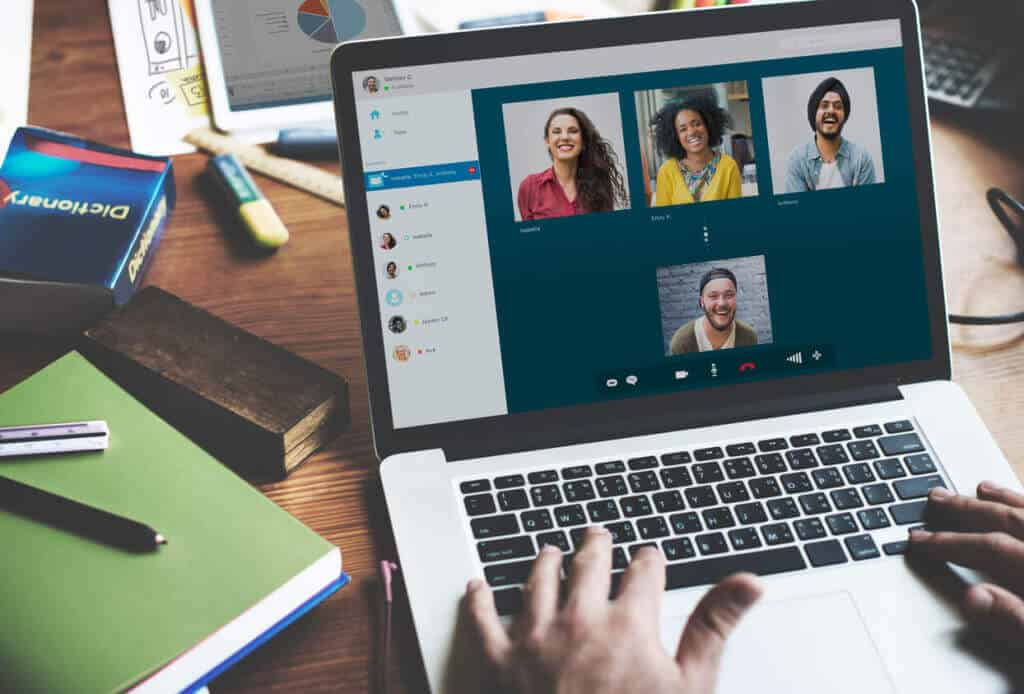
Virtual event live streaming is a type of event hosting that allows attendees to tune in from any location. This is made possible by live streaming over the internet.
Live-streaming of any type of event, whether in-person, virtual, or a blend of the two, is possible with the proper live-streaming platform, equipment, and preparation.
Some popular examples of virtual events include webinars, virtual conferences, and online classes. Many corporate events are live-streamed in order to reach team members around the world.
It is also normal for public figures with a significant following or fanbase to host virtual live-stream events, such as weddings, funerals, and other memorial services.
Benefits of Virtual Event Streaming
Many event planners are opting to host events that are strictly virtual because they come with a slew of benefits. These streaming benefits include cost-effectiveness, efficiency, and convenience.
Live streaming of events is extremely cost-effective for all parties involved. There is no need to rent out a venue, and all of the vendors are necessary to put on a top-notch event. This saves you thousands of dollars and allows you to sell tickets for less.
Guests can attend interactive virtual parties from anywhere in the world as long as they have access to WiFi. Since they don’t have to travel to the event, they save money on airfare, accommodations, and other travel-related costs.
These events are an absolute treasure when natural disasters and other situations pop up that would require to cancel them. You can easily move your event online so that viewers can still attend, and you don’t have to worry about rescheduling or issuing refunds.
Another benefit of virtual streaming events is that they can be auto-archived and played repeatedly, as long as you have the proper hosting software. If a viewer misses a bit of information, they can go back and watch it again at their leisure.
What is the Difference Between Virtual and Live Event Streaming?
Virtual event streaming and live streaming go hand in hand. The two are so similar that they are almost used interchangeably. However, “virtual event streaming” has a connotation that implies that it is an interactive event, as opposed to a live stream where participants are usually just watching the event play out.
Virtual can mean live since virtual events are live-streamed, but the interactive elements are what really differentiate the two.
The interactive aspect can be brought in with a live chat thread, allowing participants to weigh in with questions or mingle. It could also be brought in with peer-to-peer conferencing technology that basically allows attendees to join via live video chat.
In the professional world, Q&A sessions are a popular way to involve the audience and make a virtual event feel more personal and interactive.
How Does Virtual Event Streaming Work?

Imagine hopping on a Zoom or Skype call with some associates and talking to them in real time through video chat. Now, imagine “video chatting” with hundreds or thousands of people. Virtual event streaming works similarly to that.
You choose or create a site where people will sign in to see you speak. Depending on the portal, viewers may be able to interact in a chat room or discussion board.
Once you set up your portal and everybody has the invite links, you get in front of the camera and present your content.
Just like an event that you’d host in person, you would market and sell tickets ahead of time. Presenters prepare and rehearse their content, but instead of talking to a room full of people, they talk to a camera.
3 Virtual Streaming Options
There are three popular ways in which you can broadcast your virtual event, including:
- Streaming your event in real-time
- Streaming it with a slight delay
- Recording your stream and uploading at a later time
People can interact and weigh in when you stream an event in real-time, making Q&A sessions possible. This is what makes the event feel more real and engaging.
However, streaming live conferences in real-time gives you no room to correct mistakes. If something embarrassing or inappropriate happens, there is no time to censor it. That’s where low latency streaming or a live stream delay comes into play, offering a happy medium. Viewers can still interact, but you can censor any slip-ups.
When you record the stream to be watched at a later time, this can take away from the “realness” of a virtual event.
We recommend both live streaming and VOD content for uploading the video for playback at a later time. This way, viewers can participate in the event and watch it later at their leisure.
Virtual Holiday Event Ideas for 2024
The holiday season offers endless opportunities to host creative and festive virtual events. Here are a few ideas for hybrid events to bring holiday cheer to your attendees:
- Interactive Virtual Parties: Host a themed online gathering with live music, trivia, or virtual cocktail-making sessions. Many platforms can support breakout rooms for mingling.
- Live-Streamed Holiday Concerts: Feature a local choir, band, or solo artist performing holiday classics. Use different platforms to broadcast high-quality audio and video.
- Interactive Cooking Workshops: Share a festive recipe through an interactive cooking class. Encourage participants to cook along and showcase their creations in real-time.
- Charity Fundraisers and Telethons: Spread the spirit of giving by hosting a live-streamed charity event. Include live donation tracking, guest speakers, and community stories to engage viewers.
- New Year’s Eve Countdown: Celebrate the New Year with a virtual countdown, complete with live DJ sets, fireworks visuals, and interactive chat features for global audiences.
- Family and Friends Gatherings: Use video conferencing platforms to host virtual family gatherings with games like holiday bingo, gift exchanges (via delivery services), or storytelling sessions.
How to Host a Virtual Live Stream Event
Streaming events live is pretty simple as long as you prepare beforehand. This means choosing the appropriate software and hardware, preparing your content, and doing trial runs.
Ideally, this would be planned at least a few weeks in advance in order to make the process more enjoyable and less stressful for the planners. However, a last-minute shift from an in-person event to a virtual event is totally possible.
Here are six steps that streamers can follow to make their virtual events a success.
1. Choose the Appropriate Video Hosting Software
Video hosting software is essential for streaming a virtual event. There are several free, consumer-grade platforms on the internet. Unfortunately, these have limited capabilities regarding security, monetization, white-labeling, and other aspects that contribute to the all-around professionalism of your content.
To host a top-notch virtual event, you need to invest in a professional video-hosting software solution. There are some features you should prioritize in order to reach your goals.
Here are a few things you should know before choosing video hosting software.
What is a Video Hosting Platform?
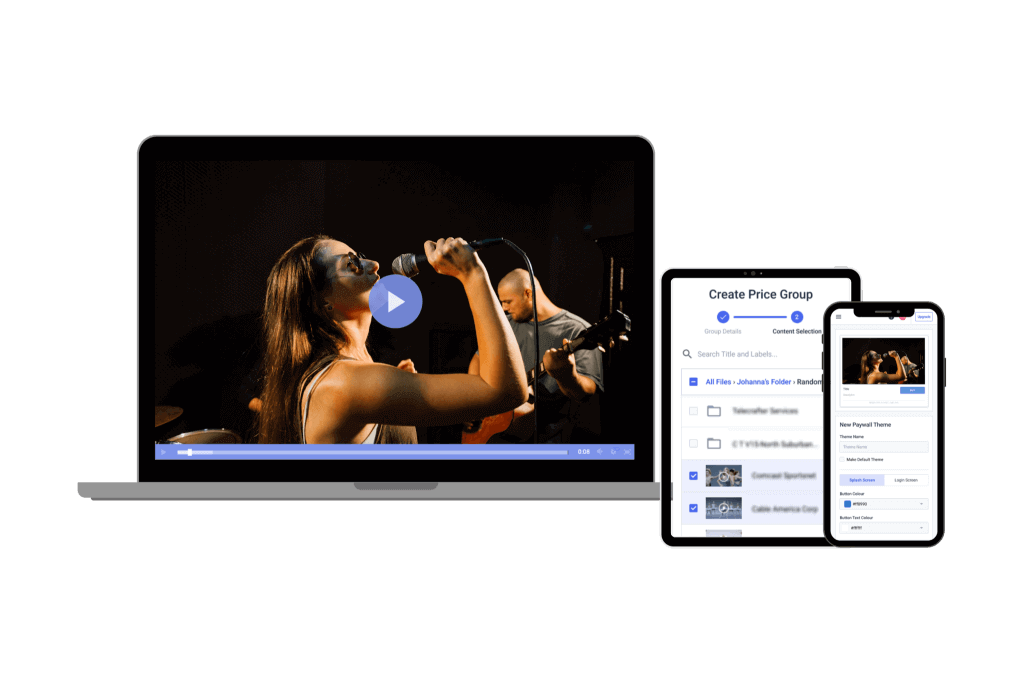
A video hosting platform is the technology used to host online videos. Online video platforms like Dacast are built to help you broadcast videos on your website. Video hosting platforms are professional alternatives to YouTube, which are completely white-labeled and give you total control over your content.
If your goal is to self-host video live-stream events, you have to ensure the platform you choose has live-streaming capabilities. Invest in a package that can withstand the volume of viewers you expect to join your virtual event.
You’ll want to check that your online video hosting has the privacy and security features necessary for secure streaming. Password-protected streaming is particularly valuable for streaming events that are paid or invite-only.
Learn more about the features of a secure OVP to ensure your event reaches your desired audience.
What is OTT (Over-the-Top)?
Currently, most online video platforms use over-the-top (OTT) technology to broadcast video content. With virtual event live streaming, you will likely tap into the tools that are built into your online OTT hosting platform of choice.
OTT streaming services use the internet to bring the video to the consumers rather than cables, satellite dishes, or rabbit ears.
Netflix, Hulu, and other major streaming services use OTT solutions. Video communication services, such as Skype and Zoom, also use OTT.
What is a Video on Demand (VOD)?
Video on demand (VOD) allows users to stream videos at their own convenience. VOD is not live streaming, but it makes it possible to stream content after it has been recorded.
Platforms with VOD hosting capabilities are a great tool for hosting a virtual streaming event because they allow you to upload the stream for viewers who either missed the event as it aired or wish to watch it again.
Private Video Hosting
The nature of virtual event streaming calls for enhanced security. Virtual events typically allow for audience participation, whether in a chat thread or a video conference. These events are also monetized, meaning your OVP stores sensitive information.
Choosing a private video hosting platform with advanced security features is a must. Password protection is good for the first line of defense. Still, advanced features like DRM, tokenized security, domain restrictions, and IP restrictions will limit your virtual attendance to qualified viewers only.
These video delivery tools will also help you keep the files and data on your OVP safe from hackers and people with poor intentions.
Top Video Hosting Platforms
While there are many video hosting platforms on the market, some are certainly better than others. If you are looking for the best virtual event platforms 2024, these are the top options:
- Dacast
- Wistia
- IBM Cloud Video
- Linkedin Live
- Brightcove
- Kaltura
- Vidyard
- JWPlayer
- Livestream
- Panopto
- SproutVideo
- Hippo Video
- Cincopa
- Muvi
- DailyMotion
- Vimeo Live
- YouTube Live
- Loom
- Resi
- StreamYard
Pay close attention to the features that each has. Check out our professional hosting platform comparison to find the platform with the tools you need to host your virtual streaming event.
2. Invest in the Right Equipment

Your choice of equipment can make or break the quality of your virtual event. Investing in top-of-the-line equipment is worth it, especially if you plan to host multiple virtual conferences and events.
Here are a few pieces of live-streaming equipment that you need to host an amazing virtual event:
- Professional-grade live-streaming camera
- Video capture card
- Encoding software (or hardware)
- Audio capturing equipment (lapel mics are ideal)
- A tripod
- Lighting equipment (if necessary for recording space)
No matter your live-streaming budget, basic lighting equipment, and tripods are fine, but when it comes to your video-capturing device and encoding hardware, prepare to spend a little extra.
This equipment can be used more than once, so you will see a nice return on your investment if you occasionally host paid virtual events.
3. Plan Your Content and User Experience
Planning content for a virtual livestream event is much like planning content for a real-life event. You choose speakers who create workshops or presentations.
You can orchestrate your event so that it is one flowing movement with one speaker after another, or you can have sessions that mirror in-person conferences where there are break-out groups or other intermissions between speakers.
Panels and Q&As are also possible and great for making your virtual event more engaging. You just have to let attendees know beforehand how questions should be submitted.
To avoid confusion amongst your viewers, create digital pamphlets with active links to the schedule and each session. This way nobody is clicking frantically to find where the video is being broadcasted.
Set up chat rooms or discussion boards that can hold your viewers’ capacity so they can talk about what is going on in the presentation.
Kahoot is a great app that allows users to ask the presenters questions. It also allows you to build a profile and engage with others in attendance, which is very helpful for networking and building relationships with other attendees.
4. Run Through the Event Beforehand
It is a good idea to run through your entire virtual livestream event before the day it goes live. Test all of your equipment and software. Also, practice your video presentation before it’s time to go on. If you are using a slideshow, check for typos and mistakes.
If something is only “kind of” working during your trial run, make sure you have multiple backup options. Prepare for every worst-case scenario.
Also, check the battery life of all equipment. Set up extension cords or prepare backup batteries where necessary.
5. Broadcast Your Virtual Streaming Event
Once you’ve done all of your preparations and your guests are starting to log in, it is time to kick off your virtual streaming event.
There are a few last-minute things you should do right before crunch time, including:
- Wear a shirt without patterns
- Use the restroom
- Bring a drink (e.g. a water bottle) to the filming area
- Do a last-minute lighting check
- Make sure everything is plugged in
- Check the mic
One thing to keep in mind is that confidence is key, and it will single-handedly improve the quality of your presentation.
Try to enjoy the event as much as possible. If the event was in real life, you’d be able to feel the audience’s energy from the stage. Picture all of the people who are eager to watch you speak.
After the stream has ended, make sure to save the video. Even if you don’t plan to upload it for viewers to play back at a later time, it is good to have access to it so that you can watch through it when planning your next virtual streaming event.
6. Live Stream On Zoom with a Professional Video Platform

Video conferencing, in general, has made it easier for people to work from home and host remote meetings. Zoom live streaming and other conferencing tools have been used to maintain a sense of normalcy in business operations.
Many people wonder if Zoom is good for live streaming, and there is no single answer to this question. Zoom alone has some limitations, but when it is integrated with a professional video platform, it is a powerful tool for peer-to-peer conferencing. This combination can be ideal for virtual event live streaming.
Zoom is connected to the OVP as a source, just like a camera, mixer, or microphone would. That feed is then streamed to anywhere that you’ve embedded your Dacast video player. Dacast, for example, has a Zoom integration that makes this entire process seamless. Since most online video platforms do not support peer-to-peer conferencing, which is essentially a live chat feature, Zoom integrations have become valuable.
Zoom integrations on professional online video platforms (OVPs), like Dacast, have given these businesses and educators the best of both worlds. This is particularly valuable in situations where your goal is to share a meeting or conversation with a public audience.
When you host a virtual stream on a Zoom conference, you’re broadcasting a conversation between two or more people or hosting an event that may require some real-time participation from people in the audience.
How to Live Stream on Zoom with Dacast
Let’s take a look at how to live stream a Zoom virtual meeting via Dacast.
Please note that this tutorial requires you to have a Zoom Pro, Business, Education, or Enterprise account to access the “Custom Live Streaming Service” Zoom feature.
Step 1: Create Your Dacast Live Stream
- Log in to your Dacast account
- Go to the “Live Stream” section on the left-side vertical menu.
- Click “Create Live Stream” on the right side of your screen.
- Enter a stream name, then select the type of stream.
- Click “Create”

Your live stream should now appear in your live streams list. You can manage the stream by clicking the “Edit” icon on the right side.
Step 2: Enable “Live on Custom Live Streaming Service”
- Log in to your Zoom account.
- On the vertical menu to the left navigate to Admin.
- Click “Account Management” then “Account Settings.”
- In the section “In Meeting (Advanced)” under the meeting tab, turn on the option “Allow Live Streaming Meetings” and check the sub-option “Custom Live Streaming Service”

Update the instructions so the meeting organizer can configure the required settings when scheduling the meeting. You can find these instructions in your Dacast account.
Edit the live channel you want to use to stream the Zoom meeting. Under the “General” tab, click “Encoder Setup,” and use the copy icon to copy and paste the required values into your Zoom account:

Make sure to use the following format:
| Stream URL: rtmp://{Username}:{Password}@{Server (without rtmp://)} Stream key: {Stream Key} Live streaming page URL: you can use your website URL or the Share Link in the General tab of the live stream. |
This is what it should look like:
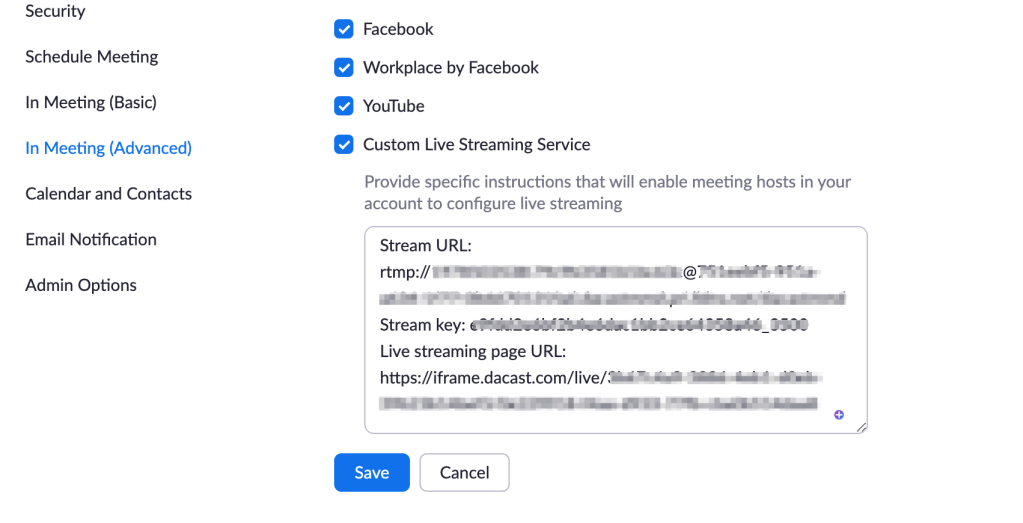
Step 3: Set Up Your Zoom Custom Live Streaming Meeting
On your Zoom account:
- Click “Meetings” then “Schedule a New Meeting
- Enter the required information
- Click “Save” to display advanced options:
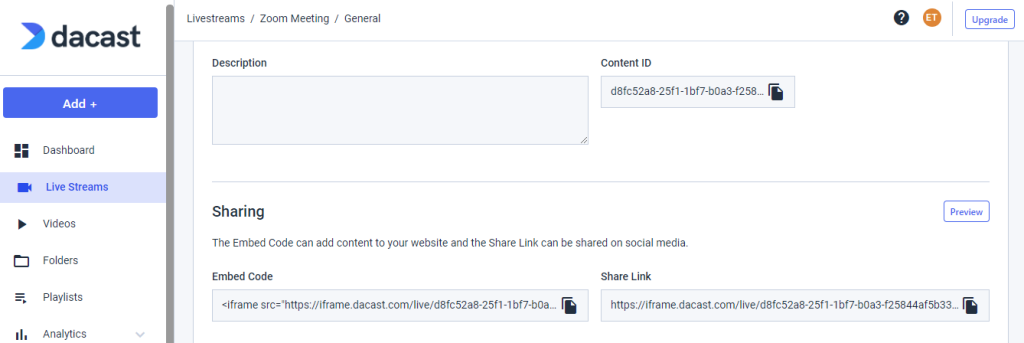
Click the “Live Streaming” tab at the bottom of the page. Then, click the “Configure Live Stream Settings” link:
 Apply the information in the green box in accordance with the format we provided in Step 2:
Apply the information in the green box in accordance with the format we provided in Step 2:
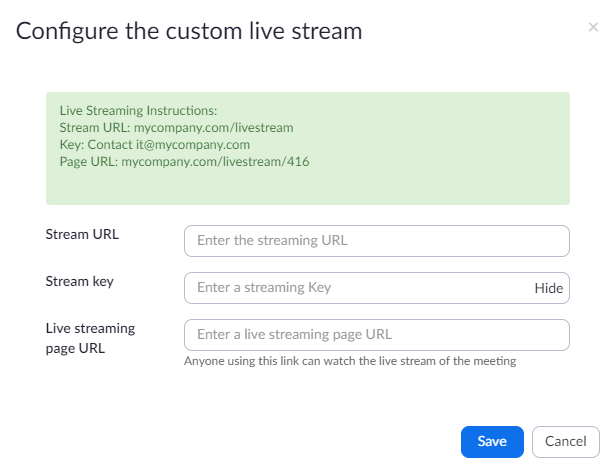 Click “Save” to save your live streaming settings. Now, the host will be able to livestream this meeting without having to add these settings after the beginning of the event.
Click “Save” to save your live streaming settings. Now, the host will be able to livestream this meeting without having to add these settings after the beginning of the event.
Step 4: Start Streaming
On your Dacast account, make sure that the live stream used for the meeting is set to “Online”:

Open the Zoom application or web portal, and start your meeting. At the bottom of the Zoom window, click the “•••” icon and select “Live on Custom Live Streaming Service.”
If the Streaming URL, Streaming key, and Streaming page URL have not been entered at this point, Zoom will open a window where you can paste these values from the Encoder Setup section of your Dacast live streaming setup.
You are now ready to live stream your Zoom meeting straight to your website via Dacast.
Bonus: Host a Virtual Holiday Event Online

The holiday season presents many opportunities for virtual event live streaming. Organizations like grade schools and churches can host virtual streaming events, such as Christmas programs, pageants, concerts, sing-alongs, and other special ceremonies, to open attendance and participation for those who wish to join but can’t be there in person.
However, holiday virtual events go beyond Christmas and New Year’s. Here are additional opportunities to consider in 2024:
- Hanukkah Celebrations: Live-stream menorah lighting, music performances, or interactive dreidel games to bring the community together.
- Kwanzaa Observances: Host a series of events that honor the seven principles of Kwanzaa through virtual storytelling, performances, and cultural workshops.
- Diwali: Although celebrated earlier in the year, you can create an evergreen virtual Diwali festival repla, showcasing live dance performances, cooking classes, and cultural discussions.
- Winter Solstice Gatherings: Host a reflective and inspiring virtual event celebrating the Winter Solstice with guided meditations, yoga, or poetry readings.
We recommend checking out our dedicated virtual holiday event streaming guide for more information on hosting interactive virtual parties.
Conclusion
With the holidays fast approaching, virtual event live streaming is the perfect way to connect, celebrate, and share the festive spirit. You can deliver a memorable and engaging experience for your audience simply by incorporating creative event ideas, leveraging the latest platforms, and following best practices.
Hosting a virtual streaming event is quite manageable, especially if you follow the six steps that we discussed above. Please remember that the user experience will depend greatly on the quality of the equipment and programs you use.
Need expert help to bring your virtual holiday event to life? Platforms like Dacast offer professional and innovative solutions to elevate your stream. Sign up for the 14-day risk-free trial and explore the possibilities!
For exclusive offers and regular live streaming tips, you’re also welcome to join our LinkedIn group. Additionally, feel free to contact our team with specific questions; we’re here to help!
Lastly, do you have further questions, thoughts, or feedback about this article? If you do, we’d love to hear from you in the chatbox below, and we will get back to you.
Let’s make this holiday season the most connected yet!
 Stream
Stream Connect
Connect Manage
Manage Measure
Measure Events
Events Business
Business Organizations
Organizations Entertainment and Media
Entertainment and Media API
API Tools
Tools Learning Center
Learning Center Support
Support Support Articles
Support Articles